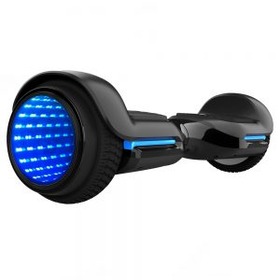
Is it fun to ride a scooter? If we asked millions of children worldwide, they would surely enthusiastically respond in chorus. At the age of three, children whiz on modern versions of the good old scooter and cover considerable distances at great speed. Here it is the children who can serve as role models for adults because just adding an electric motor transforms a scooter into an ideal means of transport in cities plagued by congested traffic and crowded buses and trains.
The electric scooter has a significant advantage: driving it is child’s play. Just climb up, accelerate (usually with a handlebar grip) and steer. Given the low height, falls are generally excluded. The brake is usually located on the handlebar handle. It is often supported by a rear wheel brake activated with the foot—a tip: the more significant the tires, the greater the comfort and safety.
Electric scooters travel only in electric mode; human intervention is impossible as in pedal-assisted bicycles. The range of electric scooters depends almost exclusively on the battery capacity. Depending on the model, you can travel between 10 and 50 kilometers. In daily use, flexibility depends above all on size and weight, which can range from 7 to over 20 Kg. Folding models are efficient. They can be stored in the trunk or transported by train or tram.
The maximum speed depends not only on technical reasons but also on local regulations. In most cases, 20km / h is a realistic value. Individual countries and states also regulate insurance, the obligation to wear a helmet and which areas to travel in in different ways (pedestrian path? Cycle path? Road?).
All in all, whether they work with muscle strength or with a battery-powered motor, scooters are the ideal complement to tackle city traffic. They can replace a walk or a short subway ride. And if you have any doubts about fun, ask your children.
HOVERBOARD
Marty McFly had one. The hero of “Back to the Future” owned a hoverboard as early as the late 1980s. At the time, this term meant a flying skateboard. Today, hoverboards look more like Segways because they are not driven with a handlebar.
Even on the hoverboard, the driver adjusts the forward movement and the direction of travel by shifting his weight, but the management is a little more complex than the Segway. Today, hoverboards are seen more as fun objects than a means of transport and are hugely popular, especially among children. However, their strength is handling, not comfort, as they are often fitted with hard compound tires.
The maximum speed of the hoverboards is about 15 kilometres per hour. The models differ mainly in weight (about 10 to 14 kilograms) and battery range (15 to 20 kilometres).
Thanks to the compact structure and low weight, the hoverboards can be easily transported by other means. Another plus is the cost: the cheapest hoverboards cost around £249.99. From this point of view, only electric scooters can hold their own.
They came to stay. Electric bicycles have long been the protagonists of urban mobility. Pedal-assisted bicycles are trendy; the electric motor is only a support, and you also have to pedal.
Advantages of the electric bike:
Those who know how to ride a bicycle will also be perfectly happy with an electric bicycle. However, the electric impulse of the start and the often higher speeds of a regular bike require a certain mastery of the vehicle. The maximum speed is subject to specific local regulations, and 25 kilometres per hour is a realistic value. The fastest electric bicycles are often compared to small-displacement mopeds.
ELECTRIC BICYCLE
The range of electric bicycles depends on many factors, but above all, on the battery capacity and the type of use. For example, in pedal-assisted bikes, it is possible to define the pedal support to the electric motor. As a result, the range is typically between 50 and 100 kilometres, well beyond the last mile. For this reason, electric bicycles are also ideal for an out-of-town excursion or to cover the office.
Given their size and weight (from 13 to 25 kilograms), it is not always possible to transport electric bicycles by other means. Only folding bikes with electric motors can be used, even in small spaces. In general, compared to electric scooter UK, electric bicycles do not have a complementary role to the car or the subway but rather replace these means of transport.
Between saving on fuel and expensive metro tickets, an electric bike pays for itself quickly. Electric bicycles cost £249.99 to £279.99 more than their non-electrified sisters, depending on the type of drive. And because you pedal, the pedal-assisted bikes also include the bonus of free physical activity. In addition, the extra power of the electric motor will save you from arriving at the office or cinema too hot.
ELECTRIC SKATEBOARD
The premise is a must: you don’t need to be a teenager to use a skateboard. With the electric version, the skateboard application field has completely changed. From a sports or fun tool for children, it has become a personal means of transport for everyone’s micro-mobility.
For the average person, using a skateboard is not as easy as riding a scooter. Learning how to brake and accelerate requires practice by shifting your weight. In addition, the structure of the skateboard itself limits its comfort: the relatively small wheels cannot absorb vibrations and shocks.
Versatility, however, is a point in favour of the electric skateboard. You can quickly transform a used board into an electric skateboard. Or mount softer or harder wheels at will. The range varies according to the model and the type of driving, but 20 kilometres are almost always possible and are more than enough for the last daily mile.
As with all-electric vehicles, prices vary widely, from a few hundred euros to three-zero figures. However, all electric skateboards have one thing in common: they are easy to handle. You arrive at the stop, put the table under your arm and get on the means of transport.
Recommended Article: Where is the best place to buy a hoverboard in the UK




